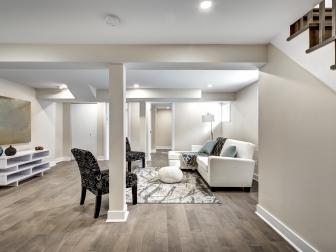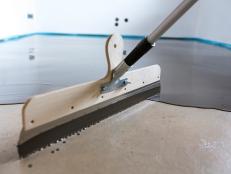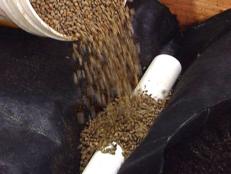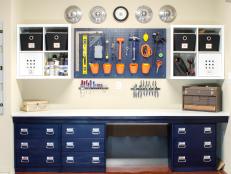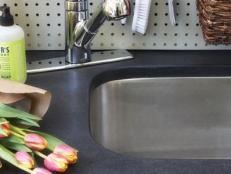Interior Basement Drainage Systems
Learn about the different systems that can waterproof your basement including French drains and sump pumps. Read on to find out how these interior drainage systems work, which type is appropriate for your home, whether it is a DIY task or you need a pro, and about how much it costs.

In an ideal scenario, water would never make it into our basements. Every home is built to manage outside water — from the rainwater falling on the roof to the groundwater around and under the foundation. Problems arise when existing systems fail, are missing or are inadequate. Your first indication may be basement water.
In This Article
- Why Do I Have a Water Problem in My Basement?
- What is a Perimeter Drainage System?
- How to Tell if You Already Have a Drainage System
- Types and Cost of Drainage Systems
- Where Does a Sump Pump Fit In?
- How Do Sump Pumps Work?
- How Do I Know What Size Sump Pump to Buy?
- The Different Types of Sump Pumps
- How Do I Get Started?
- An Important Safety Message
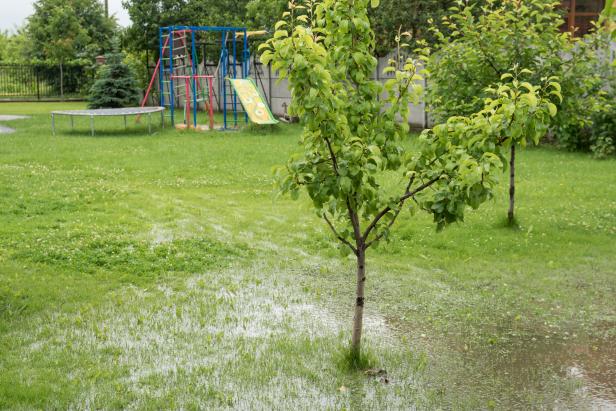
Kokhan O
If the ground around a home's foundation is holding too much moisture, it can make it into the basement. If guttering and ground re-grading aren't enough, exterior or interior perimeter drainage systems can redirect this water.
Why Do I Have a Water Problem in My Basement?
Our home foundations are porous, and under the right conditions, water will migrate or get pushed into drier areas. Knowing this, your first instinct may be to head to the aisle of foundation coatings at the home improvement store. But sealer is never one-and-done or a permanent fix for foundation water problems. Best case, you’ll be reapplying at some point. Worst case, it drives the water to another location that’s even more injurious to your home.
Instead, building scientists writing for the University of Minnesota Extension recommends checking to make sure your existing systems are doing what they’re supposed to and then considering a perimeter drainage solution.
Common Causes for a Flooded Basement
Learn how common water problems occur, how to fix them and how much you might expect to pay for remedies such as sealing, foundation repair and regrading your landscape.
What is a Perimeter Drainage System?
Think of perimeter drains as the moat (or rather, the anti-moat) for your castle. They can be located on the exterior or interior of your foundation. Exterior perimeter drains are the best because they stop the water before it ever reaches your basement, but they can be very expensive and labor-intensive to install.
That’s where an interior system comes in. You’ll hear these called different names: interior French drains, drain tile systems, basement perimeter drains and channel drains. All interior drainage systems involve a perimeter channel to accept water. Water is then routed to a collecting drain and onto a pit with an air-sealed sump pump.
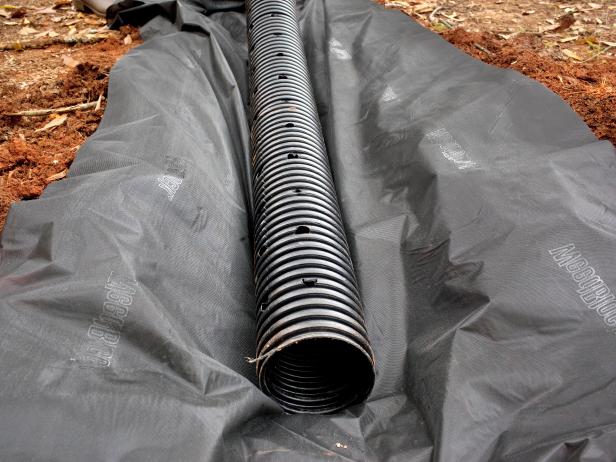
Perimeter drainage systems — sometimes called French drains or channel drains — involve a drainage channel that accepts excess water and redirects it away from the property. These drainage systems can be located on the home's exterior, but also as interior drainage systems, installed where the basement slab meets the foundation wall inside.
How to Tell if You Already Have a Drainage System
If you’re looking at a metal grill in the middle of your basement floor, you may be asking yourself that question. A basement floor drain looks like a bathtub drain and is also involved in your home’s water management. But its job is to allow water from appliance failures and plumbing leaks to have somewhere to go. For this reason, floor drains are located at the lowest part of the basement or close to appliances that might decide to blow a gasket. Floor drains usually have a trap and are routed to a sump, or straight to your septic or the sewer outside.
Types and Cost of Drainage Systems
There are three types of interior drainage systems. Where they primarily differ from one another is the location of the perimeter channel in relation to your foundation slab. This means your foundation type can matter. In a traditional basement foundation, the walls are sitting on top of separate support footings wider than the walls. Then your floor slab intersects with the wall on top of that footing. In a monolithic foundation, the footings and slab are poured together as a single piece, and the walls are constructed on top. Walls can be poured concrete or masonry block in both foundations.
On-Slab Drainage Systems
- Description: This system is a plastic product masquerading as a foundation-wall baseboard that is installed on top of the slab with adhesive. Water collects behind the baseboard and is routed through an on-slab drain pipe to a sump pit and removed from the space.
- Best for: Poured walls and monolithic foundations
- DIY or Pro: You can do it.
- Cost: $6/foot if you DIY for SealOnce Basement System.
Within-Slab Drainage Systems
- Description: Several inches of the slab perimeter is removed to create a gravel drain channel within the slab and on top of your footer. A drain is then routed to an under-slab drain pipe running to the sump pit. In block walls, the lower row is drilled with weep holes to allow water to drain into the channel that would otherwise fill the blocks. The removed concrete slab is replaced, and the foundation walls are vapor-sealed to direct moisture down to the drain.
- Best for: Traditional foundations with poured or block walls
- DIY or Pro: Advanced DIYers may be able to do it but should have a professional back-up.
- Cost: $40 to $85 per linear foot if you get help, according to HomeGuide.
Below-Slab Drainage Systems
- Description: A foot of the slab perimeter is removed so a perforated pipe can be placed in a channel below the slab and within the footings. Block walls require the same weep-hole treatment as the within-slab systems. For poured walls, a dimpled sheet is used to direct water coming from the foundation wall into the channel. Per usual, the water is then routed to an under-slab drainage pipe and onto the sump pit.
- Best for: Traditional foundations with poured or block walls
- DIY or Pro: A pro is useful for this one. You have to remove more of the slab perimeter than the other types of drains, and you don’t want to accidentally upset your foundation footings with your excavation. That would be a very expensive problem.
- Cost: $4,000 to $17,000 including the sump pump(s) and based on basement size, according to HomeGuide.
Where Does a Sump Pump Fit In?
Surface water seeping in from the side, rising water due to arguments between your home and the water table. Wherever it’s coming from, the sump pump is here to help. It can keep groundwater levels below the level of your interior and is an integral part of the drain systems we mentioned by moving collected water out of the home.
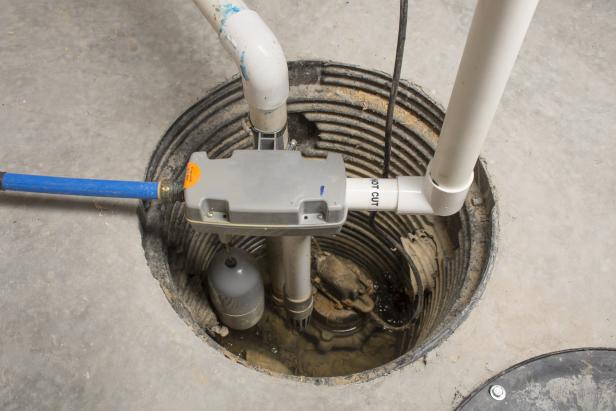
A sump pump is an important aspect of basement moisture control for many households. It accepts the groundwater from a drainage system and pumps it out of the home.
How Do Sump Pumps Work?
Sump pumps are installed in the basement floor in a specially dug pit (called a sump or basin) with a liner and a gravel bottom. Water entering the sump triggers a switch that then activates the pump to push the water through a discharge pipe and out of the home. A check valve prevents the backflow of water. The pump requires a source of GFCI-protected electric power, but backup pumps operate on battery or even home water pressure.
How Do I Know What Size Sump Pump to Buy?
Sump pumps are made of cast iron, steel and plastic, with a variety of switch types, but the pump size is the first factor to consider. Models are sized by horsepower (hp), from 1/3-hp to 1-hp. The appropriate size is determined by the amount of water the pump will contend with and how far (and how high) it has to push that water. Most homes can get away with a 1/3-hp sump pump, but deep basements or floodplain homes likely require 3/4-hp units or larger, according to Home Depot.
The Different Types of Sump Pumps
The next decision will be deciding between the two primary types: submersible or pedestal. Whichever you go with, the sump should have an air-sealed cover to keep stuff from falling in. It will also keep humidity levels down and prevent radon and other soil gases from gaining entry to the basement.
Submersible pumps have the motor and pump as a single unit that resides totally within the sump. Submersible systems are quieter, are powerful enough to push out small debris, and have the added benefit of taking up less space in your basement area. Pedestal pumps have their motors separate, sitting above the sump. Pedestal systems are less expensive and can be used in tighter sump situations because the motor isn’t in the pit.
- DIY or Pro? Replacing a sump pump is DIY all day long, but installing a new one is likely a pro job. It requires some confidence (digging a hole in your foundation for the sump) and skill (routing that discharge pipe appropriately). That said, if you’re already installing your perimeter drain, maybe you know what you’re doing and should keep that jackhammer handy.
- Cost: Plastic pedestal sump pumps can be as low as $75 for a 1/3-hp unit, and $100 and up for a 1/4-hp plastic submersibles. Metal models are $200 and up. Kits that include the sump liner, discharge pipe and cover start at $375. Sump pump installation averages $500-$1,200, according to HomeGuide data.
How Do I Get Started?
There is no one-size-fits-all approach to foundation water. Successful management depends on identifying the source of your moisture and then selecting the right treatment for your home construction and environment. In our article on waterproofing a basement interior, we recommend a foundation inspection by a structural engineer to direct your efforts. The advice has the advantage of coming from an objective party that isn’t trying to drum up business and might identify issues before they become expensive problems. The average cost for a foundation inspection is $550, according to HomeGuide data.
An Important Safety Message
Radon is an odorless radioactive gas that is released naturally by some materials in the soil. If it collects in our homes, it can create serious health risks. Many basement waterproofing strategies are also radon-reduction strategies, but whenever you compromise your foundation — for example, digging an interior drain or sump — you are changing your home’s relationship with its surroundings. The Center for Disease Control recommends you get a radon test kit from your state or home-improvement store and test for radon before you embark on any project, particularly basement work. If you are above the recommended level, back out and get an inspection from a certified radon professional so you can loop radon remediation into your project. If your home is in good shape on that initial test, make sure to test again after you finish.











